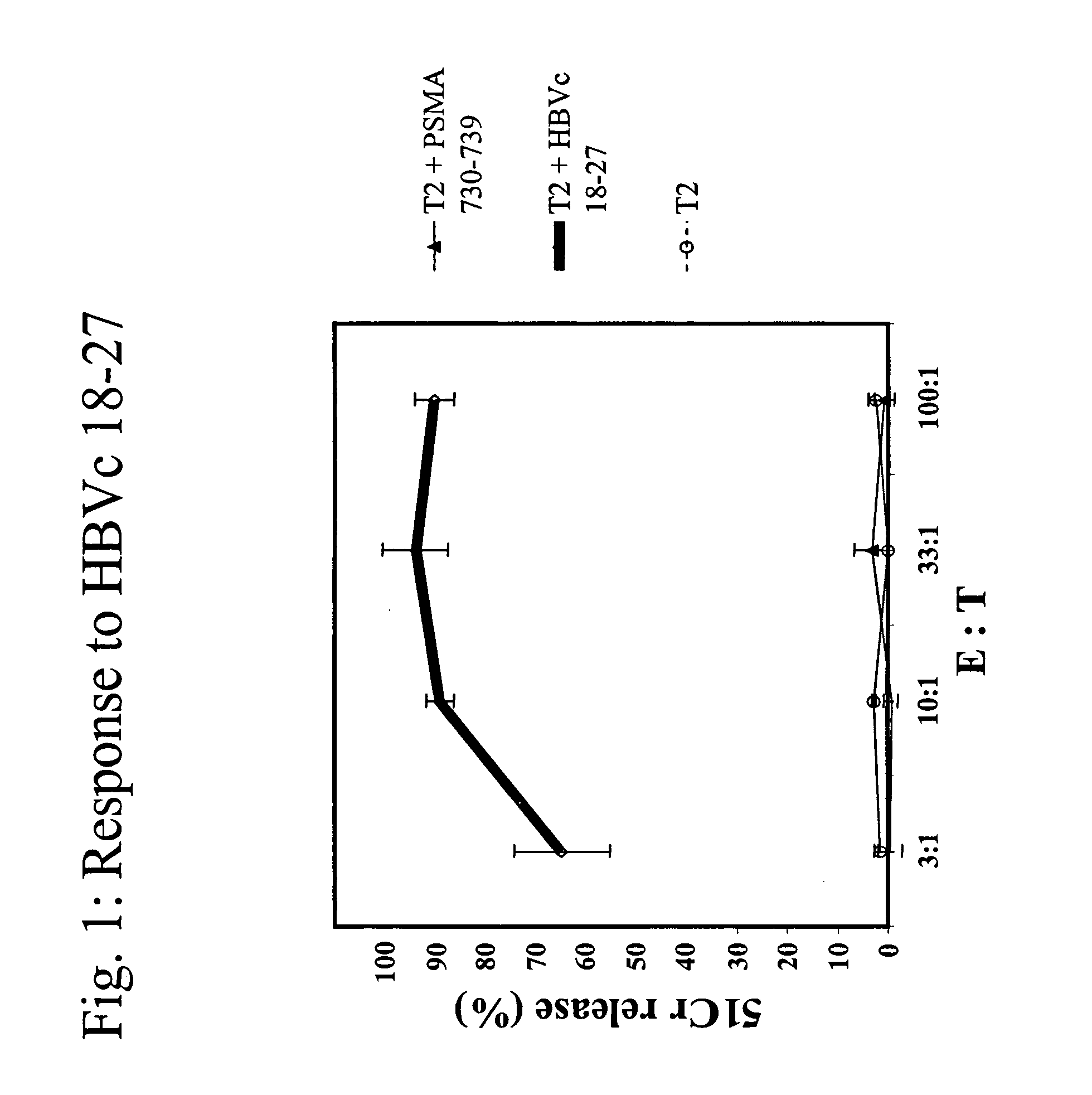Methods to bypass CD4+ cells in the induction of an immune response
a technology of immune response and cd4+ cells, which is applied in the field of methods to bypass cd4 + cells in the induction of an immune response, can solve the problems of ineffective immune response, cell response to antigens in free or soluble form, scale of hiv replication overwhelms the host immune system,
- Summary
- Abstract
- Description
- Claims
- Application Information
AI Technical Summary
Benefits of technology
Problems solved by technology
Method used
Image
Examples
example 1
Immunogenic Compositions (e.g., Viral Vaccines)
[0083]Six groups (n=6) of HLA-A2 transgenic mice are injected with 25 ug of plasmid vector bilaterally in the inguinal lymph nodes, according to the following schedule: day 0, 3, 14 and 17. The vector encodes three A2 restricted epitopes from HIV gag (SLYNTVATL (SEQ ID NO:1), VLAEAMSQV (SEQ ID NO:2), MTNNPPIPV (SEQ ID NO:3)), two from pol (KLVGKLNWA (SEQ ID NO:4), ILKEPVHGV (SEQ ID NO:5)) and one from env (KLTPLCVTL (SEQ ID NO:6)). Two weeks after the last cycle of entrainment, mice are injected with mixtures encompassing all of these five peptides (5 ug / peptide / node bilaterally three days apart). In parallel, five groups of mice are injected with individual peptides (5 ug / peptide / node bilaterally three days apart). Seven days later the mice are bled and response is assessed by tetramer staining against each peptide. Afterwards, half of the mice are challenged with recombinant Vaccinia viruses expressing env, gag or pol (103 TCID50 / mous...
example 2
Induction of Immune Response to MHC Class I-Restricted Epitopes by Intranodal Administration of Peptides Corresponding to Such Defined Epitopes and Adjuvant (Synthetic dsRNA)
[0086]A*0201 transgenic mice (n=4 / group) were immunized with the following known MHC class I restricted peptide epitopes: HBVc 18-27 (FLPSDFFPSD; SEQ ID NO:7), PSMA 730-739 (RQIYVAAFTV; SEQ ID NO:8), PRAME 300-309 (SLLQHLIGL; SEQ ID NO:9) or PRAME 425-433 (ALYVDSLFFL; SEQ ID NO:10) admixed with synthetic dsRNA (poly(IC), by direct inoculation into the inguinal lymph nodes using 12.5 μg peptide+12.5 μg of adjuvant, in 25 μl of PBS / each inguinal lymph node at day 0, 3, 14 and 17).
[0087]One week after the final administration, splenocytes were stimulated ex vivo with 10 μg / ml of the same peptide in presence of 5 U / ml of rIL-2 and tested in a standard cytotoxic assay, against: 51Cr-labeled target cells (T2 cells) uncoated, coated with cognate peptide or negative control peptide, at various Effector:Target ratios (FI...
example 3
Specific Activation in the CD8+ Lymphocyte Subset
[0089]Splenocytes isolated from pSEM plasmid primed, Melan-A 26-35 (A27L; SEQ ID NO: 1) peptide boosted HHD-1 transgenic mice were stimulated with a Melan-A specific tetramer reagent for 4 hrs. A fuller description of pSEM can be found in U.S. Patent Publication No. 2003-0228634, published on Dec. 11, 2003, and in U.S. Patent Publication No. 2005-0079152, published on Apr. 14, 2005 each of which is incorporated herein by reference in its entirety. Cells were then washed and stained with a rat anti-mouse CD8 antibody for 30 minutes. Cells were washed, permeabilized, and then stained intracellularly with anti-mouse-IFN-γ antibody for 30 minutes. Cells were washed, fixed and analyzed on a FACS Calibur flowcytometer. A gate (R1) was drawn around the total lymphocyte population (FIG. 4A) and the percentage of Melan-A antigen specific CTLs was determined by co-staining with CD8 (FIG. 4B). It is seen in FIG. 4C that only CD8 positive cells w...
PUM
| Property | Measurement | Unit |
|---|---|---|
| composition | aaaaa | aaaaa |
| length | aaaaa | aaaaa |
| size | aaaaa | aaaaa |
Abstract
Description
Claims
Application Information
 Login to View More
Login to View More - R&D
- Intellectual Property
- Life Sciences
- Materials
- Tech Scout
- Unparalleled Data Quality
- Higher Quality Content
- 60% Fewer Hallucinations
Browse by: Latest US Patents, China's latest patents, Technical Efficacy Thesaurus, Application Domain, Technology Topic, Popular Technical Reports.
© 2025 PatSnap. All rights reserved.Legal|Privacy policy|Modern Slavery Act Transparency Statement|Sitemap|About US| Contact US: help@patsnap.com



